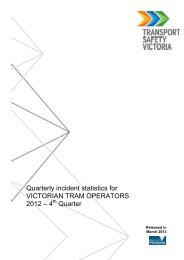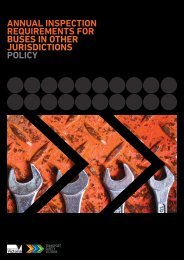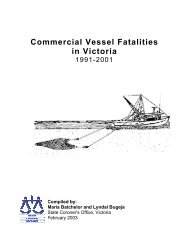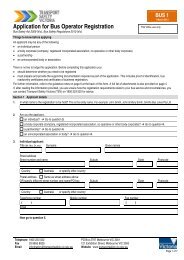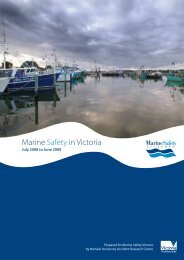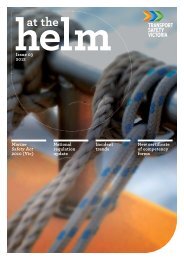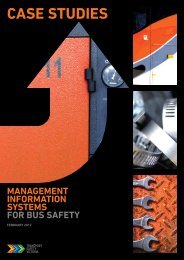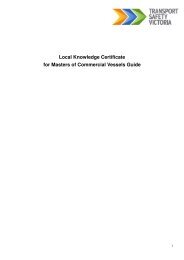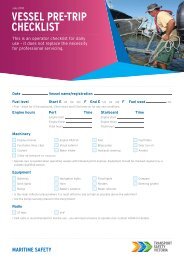Marine Safety in Victoria Report 2007-2008 (PDF, 1.3 MB, 72 pp.)
Marine Safety in Victoria Report 2007-2008 (PDF, 1.3 MB, 72 pp.)
Marine Safety in Victoria Report 2007-2008 (PDF, 1.3 MB, 72 pp.)
You also want an ePaper? Increase the reach of your titles
YUMPU automatically turns print PDFs into web optimized ePapers that Google loves.
• Nearly half (48%) of vessels were 4.8-8m <strong>in</strong> length, 30% were 0-4.8m <strong>in</strong> length, 4% were 8-12m <strong>in</strong> length<br />
and 2% were greater than 12m <strong>in</strong> length.<br />
• Half the <strong>in</strong>cidents occurred <strong>in</strong> the 3-month period November to January (late Spr<strong>in</strong>g and Summer);<br />
<strong>in</strong>cidents were lowest <strong>in</strong> W<strong>in</strong>ter (9%).<br />
• In all, there were 1,170 recorded contributory factors to response-only recreational vessel <strong>in</strong>cidents.<br />
Material factors made the greatest contribution (61% of factors, mostly mach<strong>in</strong>ery and electrical<br />
equipment failures), followed by human factors (35%, mostly lack of ma<strong>in</strong>tenance and lack of fuel), then<br />
environmental factors (4%, mostly unfavourable w<strong>in</strong>d or sea conditions).<br />
Serious <strong>in</strong>cidents (n=165)<br />
• There were 165 serious <strong>in</strong>cidents recorded on the MIR system <strong>in</strong> <strong>2007</strong>/8, an <strong>in</strong>crease of 26% on the<br />
previous year (n=131).<br />
• There were 9 deaths from 7 serious <strong>in</strong>cidents recorded on the MIR system <strong>in</strong> <strong>2007</strong>/8 compared with 5<br />
deaths <strong>in</strong> 2006/7 (<strong>in</strong>clud<strong>in</strong>g two fatalities that were recorded under response only <strong>in</strong>cidents). Deaths <strong>in</strong><br />
<strong>2007</strong>/8 were caused by drown<strong>in</strong>g (3), impact <strong>in</strong>juries related to collisions (4) and burns (2)<br />
• N<strong>in</strong>e serious <strong>in</strong>jury cases were reported on the MIR system <strong>in</strong> <strong>2007</strong>/8, one more than <strong>in</strong> 2006/7,<br />
compared with 20 <strong>in</strong> 2005/6.<br />
• Ground<strong>in</strong>g (36%), capsiz<strong>in</strong>g (18%) and collision (13%) were the lead<strong>in</strong>g causes of ‘serious <strong>in</strong>cidents’.<br />
• More than one-quarter of ‘serious <strong>in</strong>cidents’ <strong>in</strong>volved open boats (26%), followed by full cab<strong>in</strong> cruisers<br />
(22%), half cab<strong>in</strong> cruisers (19%), yachts – keel boats (12%) and PWC (8%).<br />
• Twenty-two percent of vessels were 4.8m or less <strong>in</strong> length, 38% were 4.8-8.0m., 15% were 8-12m. and<br />
6% were longer than 12m.<br />
• Over one third of vessels (35%) were cruis<strong>in</strong>g when the ‘serious <strong>in</strong>cident’ occurred. Incidents also<br />
commonly occurred <strong>in</strong> fish<strong>in</strong>g (19%), when the vessel was at anchor (13%) and dur<strong>in</strong>g sail<strong>in</strong>g<br />
(n=20, 15%).<br />
• Overall, 45% of recreational vessel occupants <strong>in</strong>volved <strong>in</strong> serious <strong>in</strong>cidents were recorded as wear<strong>in</strong>g a<br />
PFD, compared with 62% <strong>in</strong> 2006/7. The wear rate for persons on vessels up to and <strong>in</strong>clud<strong>in</strong>g 4.8m <strong>in</strong><br />
length was 58% (26/45), for vessels over 4.8m. <strong>in</strong> length the wear rate was 45% (69/152) and for vessels<br />
of an unspecified length the wear rate was 28% (9/32).<br />
• The frequency of serious <strong>in</strong>cidents was higher <strong>in</strong> December (14.5%), January (17%) and March (17%).<br />
There were few <strong>in</strong>cidents <strong>in</strong> the 4-month period May to August (12% <strong>in</strong> all).<br />
• Recreational ‘serious <strong>in</strong>cidents’ mostly occurred <strong>in</strong> enclosed waters (73%), followed by coastal offshore<br />
waters (12%) and <strong>in</strong>land waters (10%). Thirty-seven percent of reported ‘serious <strong>in</strong>cidents’ occurred on<br />
Port Phillip (n=61). Other common locations were Gi<strong>pp</strong>sland Lakes (n=28, 17%), Bass Strait (n=19, 11%)<br />
and Western Port (n=18, 11%).<br />
• Most ‘serious <strong>in</strong>cidents’ occurred <strong>in</strong> clear weather with good visibility and w<strong>in</strong>d speeds up to 8 knots.<br />
High proportions of swamp<strong>in</strong>g (62%), capsiz<strong>in</strong>g (50%) and vessel loss (60%) <strong>in</strong>cidents occurred <strong>in</strong><br />
cho<strong>pp</strong>y, rough or very rough water conditions.<br />
8



